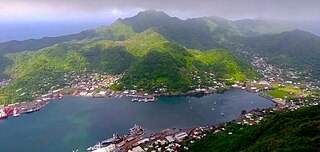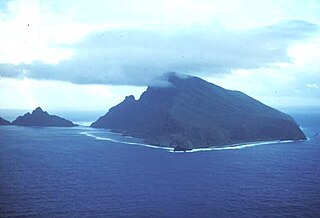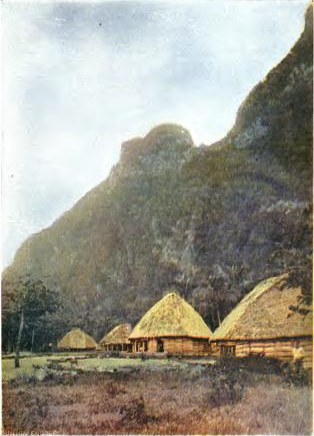Related Research Articles

The Samoan Islands were first settled some 3,500 years ago as part of the Austronesian expansion. Both Samoa's early history and its more recent history are strongly connected to the histories of Tonga and Fiji, nearby islands with which Samoa has long had genealogical links as well as shared cultural traditions.

Pago Pago is the capital of American Samoa. It is in Maoputasi County on Tutuila, which is American Samoa's main island.

The flag of American Samoa is a flag consisting of a red-edged white triangle pointing towards the hoist charged with a bald eagle clutching a war club and fly-whisk, with dark blue upper and lower triangles. Adopted in April 1960 to replace the "Stars and Stripes" as the official flag of the territory, it has been the flag of the Territory of American Samoa since that year. The colors used epitomize the traditional colors of the United States and Samoa.

The Samoan Islands are an archipelago covering 3,030 km2 (1,170 sq mi) in the central South Pacific, forming part of Polynesia and of the wider region of Oceania. Administratively, the archipelago comprises all of the Independent State of Samoa and most of American Samoa. The land masses of the two Samoan jurisdictions are separated by 64 km (40 mi) of ocean at their closest points.

Tutuila is the largest and most populous island of American Samoa and is part of the archipelago of the Samoan Islands. It is the third largest island in the Samoan Islands chain of the Central Pacific. It is located roughly 4,000 kilometers (2,500 mi) northeast of Brisbane, Australia and lies over 1,200 kilometers (750 mi) to the northeast of Fiji. It contains a large, natural harbor, Pago Pago Harbor, where Pago Pago, the capital of American Samoa, is situated. Pago Pago International Airport is also located on Tutuila. The island's land expanse is about 68% of the total land area of American Samoa. With 56,000 inhabitants, it is also home to 95% of the population of American Samoa. The island has six terrestrial and three marine ecosystems.

The Tripartite Convention of 1899 concluded the Second Samoan Civil War, resulting in the formal partition of the Samoan archipelago into a German colony and a United States territory.

The islands of Samoa were originally inhabited by humans as early as 850 BC. After being invaded by European explorers in the 18th century, by the 20th and 21st century, the islands were incorporated into Samoa and American Samoa.

The American Samoa Fono is the territorial legislature of American Samoa. Like most states and territorial legislatures of the United States, it is a bicameral legislature with a House of Representatives and a Senate. The legislature is located in Fagatogo along Pago Pago harbor.

Fagatogo is the downtown area of Pago Pago. Located in the low grounds at the foot of Matafao Peak, it was the location of the first American settlement on Tutuila Island. It includes the sub-village of Malaloa. Today, Fagatogo is the government, commercial, financial, and shipping center of Tutuila. It is also the administrative capital of American Samoa. It is the location of the American Samoa Fono (legislature), and is listed in the Constitution of American Samoa as the territory's official seat of government. Its population is 1,737.

Benjamin Franklin Tilley was a career officer in the United States Navy who served from the end of the American Civil War through the Spanish–American War. He is best remembered as the first acting governor of American Samoa as well as the territory's first naval governor.
The Constitution of American Samoa is the constitution that defines the government of American Samoa. Unlike constitutions of a state, it is subject to unilateral change by the federal government. Constitutional documents of the territory include the treaties that created it and the 1960 constitution approved by the federal government and popular referendum.

The Treaty of Berlin (1889) was the concluding document of the conference at Berlin in 1889 on Samoa. The conference was proposed by German foreign minister Count Herbert von Bismarck to reconvene the adjourned Washington conference on Samoa of 1887. Herbert von Bismarck invited delegations from the United States and the British Empire to Berlin in April 1889.

Government House, also known as Building No.1, Naval Station, Tutuila or Government House, U.S. Naval Station Tutuila, is a historic government building on the grounds of the former United States Naval Station Tutuila in Pago Pago, American Samoa. Built in 1903, it has served as a center of government on the island for much of the time since then. Government House was listed on the United States National Register of Historic Places in 1972, and was declared a National Historic Landmark in 1990.

American Samoa is an unincorporated territory of the United States located in the South Pacific Ocean, southeast of the island country of Samoa. Centered on 14.3°S 170.7°W, it is east of the International Date Line and the Wallis and Futuna Islands, west of the Cook Islands, north of Tonga, and some 500 kilometers (310 mi) south of Tokelau. American Samoa is the southernmost territory of the United States and one of two U.S. territories south of the Equator, along with the uninhabited Jarvis Island.

The Samoan crisis was a standoff between the United States, the German Empire, and the British Empire from 1887 to 1889 over control of the Samoan Islands during the First Samoan Civil War.
The Treaty of Cession of Manuʻa, also known as the Deed of Cession of Manuʻa, was a treaty between Tui Manuʻa Elisala and the United States signed on 16 July 1904 that ceded the islands of Manuʻa to the United States, which now forms part of American Samoa. It came about because of the Second Samoan Civil War and the Tripartite Convention of 1899 between the United States, the United Kingdom, and the German Empire. It was ratified by the United States Congress by the Ratification Act of 1929.
The Ratification Act of 1929 was joint resolution of the United States Congress that authorized the ratification of the Treaty of Cession of Tutuila of 1900 and the Treaty of Cession of Manu'a of 1904, which ceded the islands of Tutuila and Manu'a, respectively, to the United States and now form part of American Samoa. As such it is one of the basic Constitutional documents of American Samoa. These agreements came about because of the Second Samoan Civil War and the Tripartite Convention of 1899 between the United States, the United Kingdom, and the German Empire.
Taliutafa Christopher Leiesilika Young, also known as Christopher Taliutafa Young, Chris Young or Kilisi Young was the last claimant to the traditional title Tui Manu'a of Manu'a, a group of islands in the eastern part of the Samoan Islands. He was deposed from this title and exiled by American Governor Edward Stanley Kellogg because the idea of monarchy was incompatible with the Constitution of the United States.

Mauga Palepoi was an American Samoan chief and politician. He served as a member of the Senate
Le Mamea Makalau also known as Le Mamea MK was a Samoan high chief, judge, civil servant, diplomat, and author. Le Mamea Makalau held the high chief title of Le Mamea from Matatutu Lefaga. He held senior positions in the (precolonial) Samoan Kingdom where he served as Minister of the Interior in the government of King Malietoa Laupepa. He travelled to Washington DC as Samoa's Envoy Extraordinary and Plenipotentiary to negotiate a treaty with the United States to make Samoa a US protectorate.
References
- ↑ "GI MALALA and PULU TALALOTU (for the Mauga family and Gi family) v. AMERICAN SAMOA GOVERNMENT". American Samoa Bar Association. 17 October 2001. Archived from the original on 10 January 2020.
- ↑ Stoler, Ann Laura and Willy Brandt (2006). Haunted by Empire: Geographies of Intimacy in North American History. Duke University Press. Page 88. ISBN 9780822337249.

